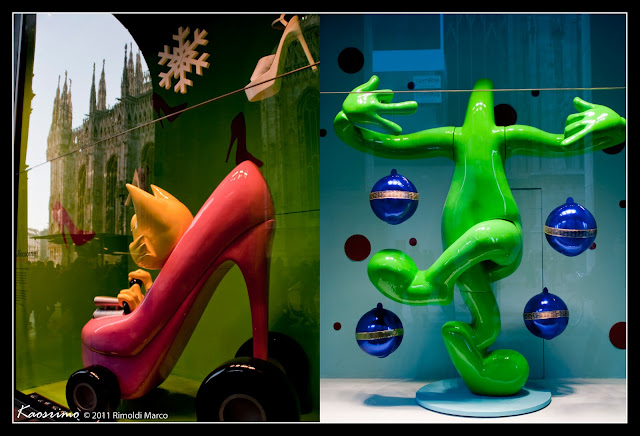16. Rinascente shopping tour

| La Rinascente di Milano è la Rinascente per eccellenza. Si trova sul lato sinistro del Duomo. | The Milan Rinascente it is the Rinascente for excellence. It is located on the left side of the Duomo. |

| Le vetrine della Rinascente sono diventate una sorta di monumento al cool. Sono da sempre mitologia milanese, immense e generalmente bislacche. | The shop windows of the Rinascente have become a sort of monument to cool. They has always been Milanese mythology. They are huge and generally outlandish. |

| Ma perché Rinascente? Nel 1865 i fratelli Luigi e Ferdinando Bocconi aprirono in via Santa Radegonda a Milano il primo negozio italiano in cui erano venduti abiti pre-confezionati. Nel 1917 Senatore Borletti rilevò l'attività, puntando sull'eleganza dei grandi magazzini e impegnandosi immediatamente ad aumentare la qualità della merce venduta, pur senza alzare eccessivamente i prezzi. Lo scopo annunciato era un approccio "democratico" al mercato, ossia attirare sia clienti delle classi alte che di quelle medio-basse. Per aumentare la fruibilità del grande magazzino di piazza Duomo, questo venne arricchito di numerose attività di uso comune, fra cui una banca e un ufficio postale. Gabriele D'Annunzio nel 1917 l'aveva ribattezzata La Rinascente dopo la ricostruzione seguita all'incendio che l'aveva completamente distrutta e l'azienda divenne un luogo di ritrovo di molti artisti. Ad esempio la pubblicità veniva realizzata da Marcello Dudovich, mentre una linea di mobili fu firmata da Gio Ponti. | Why “La Rinascente”? The Bocconi brothers opened a first clothing shop named Aux Villes d'Italie in Via Santa Radegonda (next to Piazza del Duomo, Milan) in 1877, inspired. The business grew very quickly and within few years they opened stores in several more Italian cities. People were attracted by the then-new concept of exposing the clothes in plain sight and allowing customers to walk around the shop and "watch and desire". The Bocconi brothers, however, failed to support this advantage with a targeted commercial strategy, so the success was relatively short-lived. The onset of World War I worsened the decline and by 1917 the chain of stores was about to go out of business. Instead the Bocconi brothers sold to entrepreneur Senatore Borletti, who went looking for ideas to relaunch the business. He hired decadent poet Gabriele d'Annunzio, arguably the most influential figure in the Italian culture at the time, to suggest a new public image for the store. The poet suggested La Rinascente (i.e. "she who is born again") as the new name, to symbolize the rebirth of the store but also, and more significantly, the rebirth of Italy at the end of a war which was causing widespread poverty. On Christmas night, 1918 - the first Christmas in peacetime - a short circuit caused the renovated main store in Piazza del Duomo to burn to the ground. When it opened again after being rebuilt, the name had a new meaning besides the original: that of a place which had been literally "born again" from its ashes. The Borletti family kept ownership of the chain until the late Sixties. The stores have since kept the name suggested by d'Annunzio and are still very popular today among Italian citizens and tourists. |
| Non vi resta che farci un giro. Si parte dal basso con l’ingresso superscenografico, qui vi trovate tutti gli stand delle griffe di profumi, trucchi e cosmetica. E poi via sulle scale mobili a visitare tutti i piani del megastore. | The only thing you need to do now is a store tour. It starts from the bottom with the super scenographic entrance, here you will find the stands of the major perfume, makeup and cosmetics brands. And then on the escalator to visit all the floors of the megastores. |
| Ovviamente troverete di tutto, casalinghi, abiti da uomo, donna, bambino. In fine la vera sorpresa è l’ultimo piano, dedicato al cibo sia da acquistare ,sia da consumare vista Duomo. | Of course you will find everything, housewares, clothing for men, women and children. The real surprise is the last floor dedicated to food. You could buy it or eat it directly viewing the Duomo. |
| Immagini © 2011 Rimoldi Marco L’intero album con le immagini di questo post è disponibile su Picasa Web Album.
| Pictures © 2011 Rimoldi Marco The complete album is available on Picasa Web Album.
|





